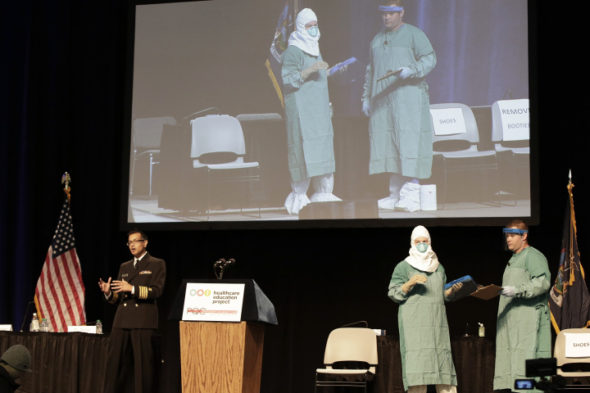Still wrong Ebola Rx
Weekly Editorial — Posted on October 23, 2014

A demonstration of dressing and removing an Ebola safety suit at an “Ebola Educational Session” presented by Greater New York Hospital Association the Partnership for Quality Care and Service Employees International Union Local 1199 United Healthcare Workers East’s “Healthcare Education Project” at Javits Center North in New York City on Oct. 21. (Photo: UPI)
(by Betsy McCaughey, NY Post) – The Centers for Disease Control and Prevention announced its new Ebola strategy Monday. Beyond more training and more protective gear for hospital staff, the CDC is also encouraging states to designate certain hospitals for Ebola preparation.
For example, Gov. Cuomo has named eight Ebola “supercenters” in New York.
The CDC is presuming that a few days is enough to make a hospital Ebola-ready. That’s a gamble.
Texas Health Presbyterian, a highly regarded 900-bed Dallas hospital, couldn’t handle Ebola. Why is the CDC betting on other hospitals to fare better?
A safer strategy would be to expand capacity at the nation’s four bio-containment hospitals, which have treated Ebola patients successfully without the virus spreading to a single health-care worker.
Most Americans have virtually no risk of getting Ebola. But doctors and nurses treating an Ebola patient are at high risk, despite CDC assurances that its “protocols” work.
Until this week, CDC Director Thomas Frieden predicted that any hospital could handle Ebola.
Those assurances proved untrue when Thomas Duncan went to Texas Health Presbyterian last month.
He died; two nurses are now infected and fearing for their lives, and 75 other hospital staff are being monitored. Oh, and the hospital itself is in serious trouble.
It would be safer to transport any patient diagnosed with Ebola to one of the bio-containment centers in Georgia, Maryland, Montana and Nebraska. That’s what authorities did with the two infected Dallas nurses last week, sending Nina Pham to the Maryland facility and Amber Vinson to Georgia.
The hitch is that these four facilities together can treat only 11 patients. Expanding capacity at these four facilities is a no-brainer, instead of outfitting hundreds of hospitals to treat Ebola.
Hospitals should be prepared to recognize possible cases, isolate them — and then call for help. Period.
Last summer, the Centers for Disease Control and Prevention announced that doctors and nurses treating Ebola should wear a waterproof gown, gloves, goggles, and a face shield. That guideline left the user’s head uncovered and skin exposed around the neck and wrists.
Sean Kaufman, an infection expert at the biocontainment facility that successfully treated Dr. Kent Brantly and Nancy Writebol (both infected in Africa) and is now treating Vinson, called the guideline “absolutely irresponsible and dead wrong.”
At a House committee hearing last Thursday, Rep. Michael Burgess (R-Texas) held up a photo of CDC chief Frieden in Africa wearing a protective suit that covered him head to toe. Burgess compared it to the flimsy guideline that the CDC had issued for nurses and doctors here.
On Monday, the CDC backed off its double standard and recommended a full body suit with head cover modeled after what Doctors without Borders caregivers wear. Will it be enough?
Not necessarily. Any error in removing the gear can expose a caregiver to vomit and other bodily fluids contaminating the outside of the gear.
So far this year, 16 Doctors without Borders medical personnel in Africa, all experienced and relying on a buddy system to avoid errors, became infected despite wearing gear. Nine of them died.
The CDC is also no longer claiming that any hospital with a single room can treat Ebola.
In an Oct. 14 nationwide conference call with hospital personnel, CDC encouraged hospitals to consider setting up an Ebola suite with a dedicated lab, because technicians working in the hospital lab are likely to quit if Ebola is brought in, and one spill would force the whole lab to shut down.
One call participant, Dr. Richard Pitts of Arrowhead Regional Medical Center in Southern California, exclaimed that making such changes “would probably bankrupt our hospital.”
In fact, treating one Ebola case can put a hospital on life support. At Texas Health Presbyterian, some 100 health-care workers exposed to Duncan are furloughed with pay and under observation.
The public is shunning the hospital. Two-thirds of beds are vacant. And Amber Vinson has hired a lawyer.
The best Ebola strategy is to protect our local hospitals, health-care workers and patients by relying on the nation’s bio-containment facilities. That’s what they were built for.
Betsy McCaughey is chairman of the Committee to Reduce Infection Deaths.
Published October 21, 2014 at The New York Post. Reprinted here October 23, 2014 for educational purposes only.
